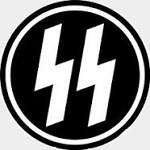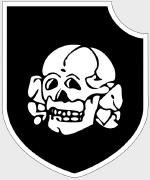Dragon DRR60449 German Sd. Kfz. 141 PzKpfw III Ausf. M Medium Tank - "Black 414", 4./Panzer.Regiment, 3.SS Panzer Division "Totenkopf", Kharkov, Russia, 1943 (1:72 Scale)
"We must do everything we can to promote anti-tank defense, and work just as hard to guarantee successful counter-attacks through the instrument of powerful tank forces of our own."
- Major-General Heinz Guderian, "Achtung Panzer!"
 As early as 1934/35, General Heinz Guderian envisioned two basic types of armor to act as the lead elements of the future German Panzer Divisions. The first vehicle was to be armed with an anti-tank gun and two machine guns while the second one was to be a support vehicle, armed with a larger caliber gun. The first one eventually became known as the Panzerkampfwagen III, which was to be a standard tank for the three light companies of a tank battalion. The second vehicle became known as Panzerkampfwagen IV.
As early as 1934/35, General Heinz Guderian envisioned two basic types of armor to act as the lead elements of the future German Panzer Divisions. The first vehicle was to be armed with an anti-tank gun and two machine guns while the second one was to be a support vehicle, armed with a larger caliber gun. The first one eventually became known as the Panzerkampfwagen III, which was to be a standard tank for the three light companies of a tank battalion. The second vehicle became known as Panzerkampfwagen IV.
In 1935, development orders for a 15-ton fully-tracked vehicle based on the specifications set down by the Waffenamt (the Ordnance Department) were issued to MAN (Nurnberg), Daimler-Benz AG (Berlin-Marienfelde), Rheinmetall-Borsig (Berlin) and Krupp AG (Essen). In order to maintain secrecy, the new vehicle was known as the
Zugfuhrerwagen (ZW) - platoon commander's vehicle. The vehicle was designated Versuchkraftfahrzeug 619, Mittlerer Traktor (Medium Tractor) and 3.7cm Geschutz-Panzerwagen.
The Panzerkampfwagen III's development arose from a conflict between the Waffenamt and the Inspector for Mechanized Troops over the vehicle's main armament. The Waffenamt selected and was satisfied with 37mm gun, while the Inspector for Mechanized Troops demanded a larger 50mm gun. In the end, the 37mm gun was chosen as the main armament for the new vehicle. The decision was based on the fact that the infantry was already equipped with the standard 37mm Pak 35/36 L/45 anti-tank gun, so only one gun and one type of ammunition needed to be produced. The turret and turret ring was still capable of mounting a heavier gun originally envisaged by the Inspector for Mechanized Troops. Armored protection was to be heavier in the front of the vehicle than the rear, since the new vehicle was to be used in forward elements of the assault tank formations. The top speed was specified to be 40km/h. and the vehicle was to be operated by a crew of five men, with a commander, gunner and loader in the turret and driver and radio operator in the forward part of the hull. Communication between crew members was handled through the use of an intercom system, the first German tank to be equipped with such a device. Later on, all of the Panzers were equipped with this system which proved to be very effective during combat.
Pictured here is a 1:72 scale German Sd. Kfz. 141 PzKpfw III Ausf. M medium tank that was attached to the 4./Panzer.Regiment, 3.SS Panzer Division "Totenkopf", then deployed to Kharkov, Russia, during the winter of 1943.
Sold Out!
Dimensions:
Length: 4-inches
Width: 1-inch
Release Date: March 2014
 Historical Account: "Death's Head" - "Totenkopf" (Plural: Totenkopfe) is the German word for "death head" or "death's head" and is used to describe a military insignia featuring a skull above crossed bones. It is distinguished from the similar traditions of the skull and crossbones and the Jolly Roger by the positioning of the bones directly behind the skull. For a long time in widespread use in several countries, its association with aspects of Nazi Germany has led to its decline.
Historical Account: "Death's Head" - "Totenkopf" (Plural: Totenkopfe) is the German word for "death head" or "death's head" and is used to describe a military insignia featuring a skull above crossed bones. It is distinguished from the similar traditions of the skull and crossbones and the Jolly Roger by the positioning of the bones directly behind the skull. For a long time in widespread use in several countries, its association with aspects of Nazi Germany has led to its decline.
In the early days of the NSDAP, Julius Schreck, the leader of the Stabswache (Adolf Hitler's bodyguard unit), adopted the Totenkopf for his unit.
This later grew into the Schutzstaffel (SS), which continued to use the Totenkopf as insignia throughout their brief history. As they had done with the Swastika, the Nazis simply adopted the Totenkopf from the historical tradition and used it for their own purposes, leaving it marked with a stigma that has continued to the present.
It is important to note that the SS "Death's Head" symbol is markedly different from the original German (Prussian) "Totenkopf", the original being much more "cartoonlike" in appearance, with the SS version appearing more "realistic." In short, they are two very different symbols.






![USAAF Boeing "Silverplate" B-29 Superfortress Heavy Bomber - "Bockscar", 509th Composite Group, Hiroshima, Japan, August 6th, 1945 [Bonus 1:72 Scale "Fat Man" Atomic Bomb] (1:144 Scale)](http://cdn4.volusion.store/qh9e9-jdqv9/v/vspfiles/photos/AF10112C-1.jpg?v-cache=1740197136)


